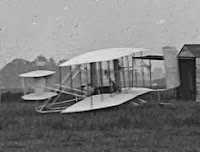"Success four flights Thursday morning all against twenty-one mile wind started from level with engine power alone average speed through air thirty-one miles longest 57 seconds inform press home Christmas"
 |
| The 1903 Flyer after it's last flight |
After the 4th flight ended with a hard landing that damaged the elevators spars on December 17th, 1903, a strong gust of wind overturned the airplane and sent it tumbling, breaking a wing spar, most of the wing ribs and several struts. The 1903 Flyer never made another flight - its total lifetime in the air amounted to about 3 minutes. After the breakthrough flight, the brothers packaged the Flyer up and shipped it back to Dayton, where it sat in a crate for 13 years. In 1916, Orville repaired it and sent it to be exhibited at MIT and other places, before it was shipped to London to be exhibited at the Science Museum where it was on display until 1948 (apart from during World War 2, when it was stored underground). Since then, it has been a centerpiece of the National Air And Space Museum.
The Wrights now returned permanently to Dayton Ohio. Although they sent out a brief press announcement in early 1904 to establish their claim, they now retreated into silence to hone their invention. The brothers got permission to use a cow pasture 8 miles outside Dayton, where they assembled the Flyer II and made the first flight on May 23rd. The 1904 Flyer II was almost a direct copy of the 1903 Flyer, with stronger landing skids and using iron bars to mount the forward elevators in order to move the center of gravity forward. Progress was slow, the elevators remained over-sensitive in pitch and the brothers remained very cautious, flying low and slow. They continued to experiment, adding a radiator and circulation system to cool the engine, and then a second radiator. They changed the vertical rudder, extended the skids, lengthened the propellers and hundreds of minor tweaks and repairs.
 |
| The 1904 Flyer II compared with the 1903 Flyer - almost identical |
It wasn't until September 15th that the Wrights exceeded 1 minute aloft, and on September 20th, they made their first complete circle of the pasture. Although the machine remained severely unstable, the Wrights had the skills now to overcome it and make flights lasting several minutes. From early September onwards, the Wrights used a catapult system to get to flying speed quickly, which greatly accelerated their progress. Over the course of 1904, the brothers made 105 flights and built up 45 minutes of airtime, culminating in a 4 circle flight on November 9th which covered 3 miles and lasted 5 minutes. The 1904 Flyer II was not seen by the brothers to be significant breakthrough, and they didn't preserve the machine.
 |
| The 1904 Flyer II in flight at Huffman Prarie, low and slow |
 |
| The 1904 Flyer on November 9th 1904, on the 4 circle flight |
On June 23rd 1905, Orville made the first flight of the redesigned 1905 Flyer III. It was larger with an upgraded engine and bigger 1 gallon fuel tank, but retained the same basic layout and controls. As a result, its stability remained a problem, and following a major crash in July that wrecked the aircraft (although Orville was unhurt), they decided on major changes. They doubled the size of the elevator and moved it much further ahead of the wings, while increasing fuel capacity to 3 gallons. They gave the wings positive dihedral, and disconnected the rudder from the wing warping controls, giving it a separate control handle. With these changes the rebuilt machine flew on August 24th, and the Wrights found its control and stability to be much improved. Soon the Wrights were routinely flying figure 8's and circles. On October 5th, during one of their first public demonstration flights Wilbur flew 24 miles in nearly 40 minutes. Four days later they wrote to the Secretary of Army, offering the world's first practical airplane.
 |
| The 1905 Flyer III as originally built, with short elevator spars and anhideral wings |
 |
| The 1905 Flyer III with longer spars and dihideral wings |
On November 7th the Wrights disassembled the Flyer III and stored it until 1908, when they prepared for an Army demonstration flight by adding 2 seats and modifying the controls. They sent it to Kitty Hawk for testing,where it was wrecked in a crash. Starting in 1914, the Flyer III was salvaged and restored, and in now on display at Carillon Park in Dayton Ohio.
 |
| The World's First Practical Aircraft, September 7th, 1905 |
1 comment:
Another great post. You will have to keep this going through the November's Aviation History month.
Post a Comment